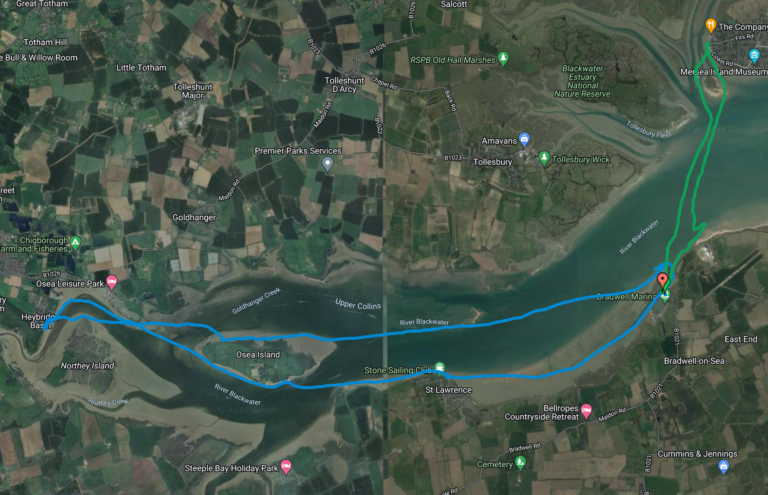3rd-4th August 2024

Six paddlers met on Bradwell Quay on a grey morning in August with a mission to fulfil. Our Essex trip differed from CKC’s usual weekend outings; it was a recce in unknown waters. We were there to explore the Blackwater Estuary for future club trips, which meant investigating as many jetties, slipways, islands, beaches, cafes and pubs as possible, noting down launch and landing points, highlights and hazards.
Our Saturday plan – drawn up by Jonathan and David with input from local paddlers – was to use the incoming tide to paddle the length of the estuary, up to Heybridge Basin near Maldon (home to the sea salt brand), then return on the ebb to Bradwell near the river mouth – a trip of 29 kilometres. Heybridge Basin looked a lively marina and tourist spot, so we anticipated cafes and facilities. As the tides dictated an early start, we arrived at 8.30am on Bradwell public slipway to offload.
We parked at nearby Bradwell Marina (£2 all day) taking a convenient footpath back to the public slipway past Munchies Café (a local legend). The Marina tower has toilets on the ground floor, and there is a clubhouse (with bar and showers) past the members-only barrier.
A sandy islet separates Bradwell Creek from the main river, so first we slipped down the creek, exiting gently into the main flow, which is around 3 miles wide at the river mouth. The wind was light (F2) but forecast to strengthen later (to F3-F4), and it did.
Our first mission was to check out two slipways on the south bank, at Stone Inn and Marconi Sailing Club. The Blackwater is surrounded by low-lying land (aka ‘The Saltmarsh Coast’), famous for internationally important bird migration routes and oyster beds. We’d checked the maps but needed to see any possible get in/out points for ourselves, especially the all-important ratio of mud to shingle.
We landed briefly at Stone Inn, where a short slipway was usable only around high water, though much of the foreshore was shingle-studded and firm.
Approaching Marconi Sailing Club on the rising tide, we saw two dozen dinghies readying for their regular Saturday race. Jonathan had a quick chat with their safety boats to avoid the sailors, then we headed towards Osea Island in midstream.
It was a lively crossing as wind against tide raised waves that came at us sideways. Happily, Osea’s shingle beaches were prefect for a quick leg-stretch. The island is privately-owned, and a few yards inland signs warned of ‘guard dogs of the loose’. Meanwhile, Mary found samphire growing wild, a delicacy when lightly steamed with butter. Sunlight was breaking through cloud, picking out white yacht hulls against the slate-coloured water and sky.
We set off again, hugging the shore up to the headland before veering into the main flow. By now, it was sunglasses weather.
The river was wide and sealike as we made towards the north bank a good distance away.
I pointed my bow at an angular rusty sculpture. It opened its sails and transformed into a magnificent Thames barge, huge vessels with sails the colour of dried blood. Four of them rounded Northey Island (a bird sanctuary) towards us, unfurling their sails as they came. They belong to the Thames Sailing Barge Trust on Maldon quay.
Their presence between us and Northey Island settled any debate about whether to go there. Instead, we followed the river’s north shore (shingle beaches, all possible rest spots, though only accessible from the sea as the leisure parks behind them are private).
Our destination was Heybridge Basin. We arrived at high water and lunchtime, as planned. Yachts were moored along pontoons, and a happy clientele was sun basking outside the pubs, but landing was limited to a steep concrete stair. We didn’t fancy hauling the boats out vertically. Luckily, we found a pontoon with gangway access to the seawall, lashed the kayaks to it, then had a quick picnic.
As the tide turned, we set off towards Northey Island, sticking close to it, then crossing the wide reaches of the river to go round Osea’s other (North) side, mostly reed beds. The causeway linking it to the mainland is only exposed at low tide.
Things got challenging after Osea Island, where the two arms of the river meet, and the flow gets stronger. A SW wind meant waves, a turbulent following sea and wind pushing us away from the shore. It was a lively slog. I enjoyed surfing the waves to make distance, but it took concentration. Subsequent conversations with local sailors revealed this bit of the Blackwater is often choppy.
Finding Bradwell on the horizon was easy; the decommissioned nuclear power station’s twin towers caught the sun. Then we passed the Radio Caroline pirate radio ship. But the outgoing tide created an entirely different coast with surf in the shallows and access to the creek limited to a narrow channel over a sandbar. We dodged homeward bound yachts on get back to the slipway. We were tired but happy from a long day of varied and interesting paddling.
Day 2: Sunday
We discussed multiple plans for Sunday before settling on a shorter paddle, setting off again from Bradwell Quay to cross the Blackwater near its mouth, going to West Mersea on the north bank.
Conditions couldn’t have been more different. Sunny from the outset, with a glassy sea. The water was smooth oyster grey-green, fittingly as West Mersea is the gateway to numerous creeks that have been famous oyster beds since Roman times. They remain the source of Britain’s biggest oyster harvest. Tollesbury Creek – a site of special scientific interest, and Old Hall Marshes are also bird nesting grounds and support rare hawks such as hen harriers. We had a gentle crossing with smooth billows mid-flow.
One sailing website describes West Mersea as “A very busy area for yachts, with narrow channels crammed with moorings.”
However, between the channels stands a low shingle island, home to The Packing Shed, a 19th century oyster packing shed, now restored and run by a charity who do half a dozen open days a year. We paddled up to look, expecting it would be locked. We were greeted by charity volunteers readying the place for a ‘Pirate Party’ kids’ day mid-week. They kindly showed us around. Inside, there’s an exhibition showing how the once-derelict structure was saved.
Back across the “narrow channels crammed with moorings”, we found the town slipway, busy with dinghies. We pulled the kayaks onto the busy pathway, ate sandwiches and explored the busy waterfront on foot.
On the return trip we practiced using transits of trees and pylons in the far distance for navigation. It was an uneventful journey. We halted so Jonathan could practice rolling, and got to see how quickly the outgoing tide pushed us downstream towards Bradwell power plant. Scrambling to recover ground, we made it back into Bradwell Creek at the end of a very satisfying weekend of paddling. The Blackwater may not be the docile winter training ground we were hoping to discover but it is an adventurous place that is well worth another visit.

